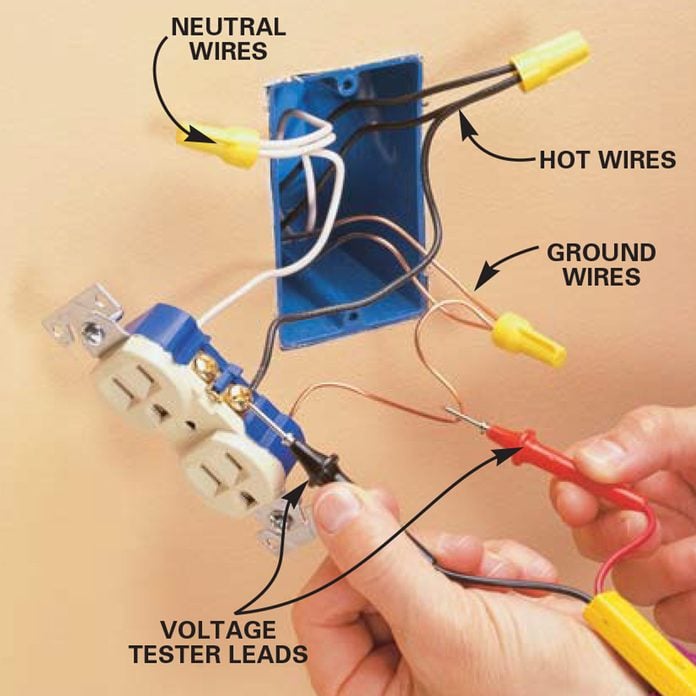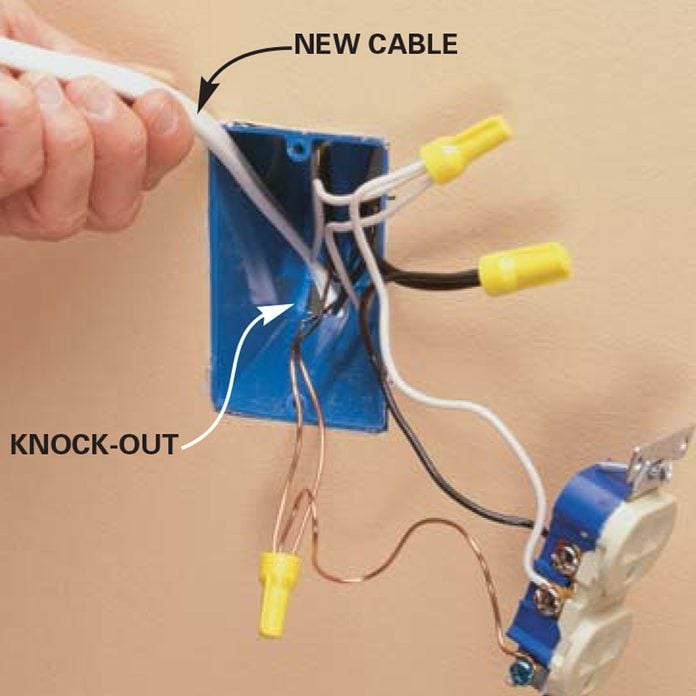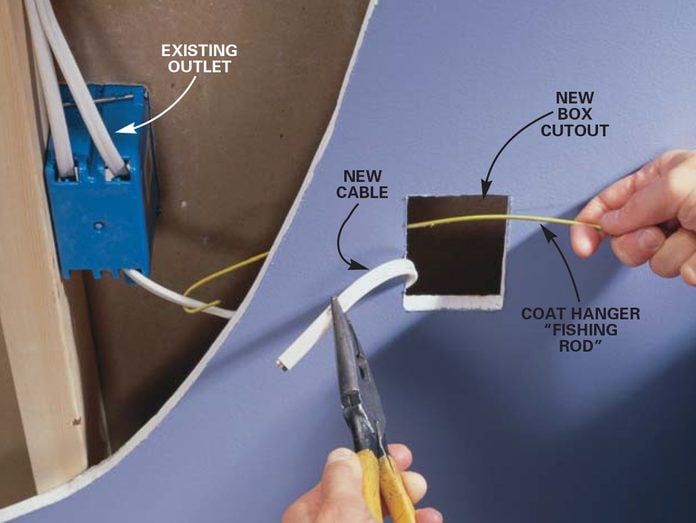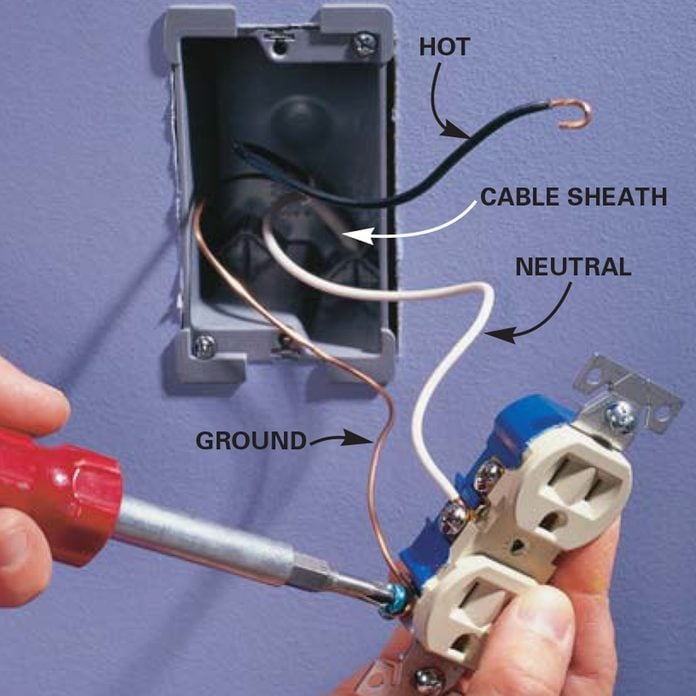How to Install an Electrical Outlet in an Existing Wall
Add an Electrical Outlet
Use this easy method to install a new electrical outlet without a lot of wire pulling.
![]() Time
Time
A full day
![]() Complexity
Complexity
Intermediate
![]() Cost
Cost
Less than $20
Introduction
Eliminate those ugly and often dangerous extension cords. You can add a new outlet quickly and easily without tearing open a wall, if you already have an electrical outlet in the other side of the wall. No extra holes. No messy patching and repainting. The procedure we show here allowed us to center our TV against a wall in the family room that had no outlet. Since there was already an electrical outlet in the other side of that same wall (facing into an adjacent bedroom), we just added a new outlet in the family room, drawing power from the bedroom outlet.
Tools Required
Materials Required
- Electrical cable
- Receptacle (outlet)
- Remodeling box
- Wire connectors
You'll Need to Find a Power Source
This technique only works if you can use an electrical outlet as a power source that's opposite, or nearly opposite, the place where you want your new wall outlet. To determine how to wire an outlet and whether you can safely use existing electrical outlets, follow the list below.
You Can Use Another Electrical Outlet When:
- If a switch or outlet is on a circuit that often blows its breaker or fuse. (Don't make matters worse by adding yet another outlet to the circuit.)
- Electrical codes restrict the number of lights or electrical outlets that can be connected to one circuit. Typically, you can have no more than eight lights or electrical outlets on a 15-amp circuit. To determine the amp rating of a circuit, just look at the number on its breaker or fuse in your main electrical panel. Turn off the circuit and test light switches and other outlets to determine exactly which lights or outlets are on a given circuit.
- Most electrical codes now require outlets in kitchens and bathrooms to be on separate 20-amp GFCI circuits. So before using the method we show here for how to wire a wall outlet in a kitchen or bathroom, check with an electrical inspector. If you add an outlet to a kitchen or bath, it must be GFCI protected. Don't power your new outlet from a kitchen or bathroom outlet.
- Codes also limit the number of wires that can enter an electrical box or electrical receptacle, depending on the inside volume of the box and the gauge of the wires. The outlet-addition methods we show here are based on the most common wiring (14-gauge wire on a 15-amp circuit) and an 18-cu.-in. box (typical inside dimensions are about 2-in. x 3-1/4 in. x 3-in. deep). If the circuit is 20-amp — which means thicker, 12-gauge wire — or if the existing box is smaller than 18 cu. in., you can't wire a new wall outlet as we show here unless you replace the existing box with a larger one. Plastic box sizes are stamped on the inside at the back.
Always confirm the required box size with your local building inspector. In most regions, you need an electrical permit for this work from your local building department. This helps ensure a safe job. These are the 8 most common national electric code violations.
Watch this video to learn how to install an electrical box in any room in your home:
ⓘ
Work Safely
Before you tackle any part of this project, turn off the power to the circuit at the main electrical panel by switching off the breaker or removing the fuse.
Before touching any bare wires or terminals on a switch or outlet, use a voltage tester on all the wires to make sure the power is off. If you have old, fabric-insulated wiring, call an electrician to recommend safe connections. With wiring an outlet like this, there's usually no ground wire and it's hard to tell the hot wire from the neutral, because both are coated with black insulation.
Project step-by-step (5)
Step 1
Shut Off the Electrical Outlet
- Turn off the power at the main panel. Find the correct breaker and turn it off.
- Once you've determined the electrical outlet to use as a power source and shut it off, use an electronic stud finder to locate the studs on both sides.
- You can put your new outlet anywhere between these two studs.
- Unscrew the outlet and use a voltage tester to double-check that the power is off.
- With either lead touching a ground wire (bare copper), touch the other lead first to the neutral terminals (silver colored), then to the hot terminals (gold colored).
- If the light glows with either contact, the circuit is still live.
- Hold the face of the new electrical box against the wall where you want it to go, and trace around it with a pencil.
- Cut out the hole with a drywall saw.
- Pro tip: Be sure to buy a "remodeling" box that can be secured to the drywall, not one that must be mounted on a stud.
- Next, using a screwdriver, unscrew the existing outlet on the other side of the wall outlet from its box and punch out one of the knock-outs at the back of the box.
Here's how to use electrical testers.
Aluminum wiring requires special handling. If you have aluminum wiring, call in a licensed pro who's certified to work with it. This wiring is dull gray, not the dull orange that's characteristic of copper.

Step 2
Feed New Cable into the Wall
- Feed a length of new cable through one of the knock-out holes at the back of the existing box (punch out the hole with a screwdriver).
- Feed through enough cable to reach the new box plus an extra foot.
- Use 14-gauge wire for a 15-amp circuit.

Sign Up For Our Newsletter
Complete DIY projects like a pro! Sign up for our newsletter!
Do It Right, Do It Yourself!
![]()
Step 3
Rewire the Existing Electrical Outlet
- Connect the wires of the new cable to the existing wires.
- Strip about 10 inches of plastic sheathing from the new cable to expose the black, white and copper wires.
- Run the new cable, with sheathing, at least two inches up inside the box, and double over the excess wires to help hold the cable in place.
- Strip 5/8-in. of insulation off the ends and connect the wires from the new cable to the existing bundles — white to white, black to black, ground to ground.
- Use new wire connectors of adequate size for the four wires in each bundle.

Step 4
Fish the Cable to the New Location
- Mark the opening for the new box and cut it out with a drywall saw.
- Fish for the new cable with a hook made from a wire coat hanger.
- Pull the cable through the opening cut in the wall.
- Then strip about nine inches of sheathing off the end of the cable. Insert the cable so the sheath extends about one inch into the box and mount the box in the wall.

Step 5
Wire the New Electrical Outlet
- Mount the new box in the opening.
- Connect the new wires to the new outlet: white (neutral) wire to a silver-colored terminal screw; black (hot) wire to a gold-colored terminal screw; bare wire to the green grounding screw.
- Make sure the cable sheath remains secured inside the box
- Finally, call the electrical inspector to check your work.

Similar Projects
How to Install an Electrical Outlet in an Existing Wall
Source: https://www.familyhandyman.com/project/add-electrical-outlet/